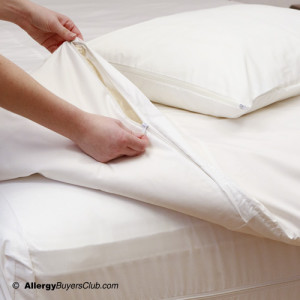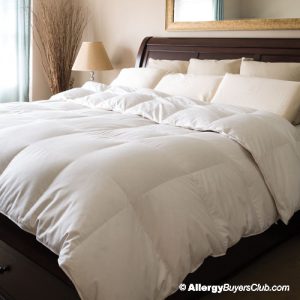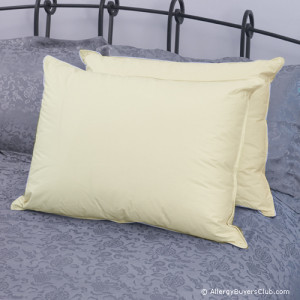6 Tips For Choosing Allergy Bedding
Allergens are everywhere … in the outdoor air, in your indoor air and … IN YOUR BED !!!
 Do you wake up with a runny nose, watery eyes or a scratchy throat? If yes, you are most likely being exposed to something that is causing you an allergic reaction. Thankfully, there are some allergy bedding products that can improve the conditions in your bedroom.
Do you wake up with a runny nose, watery eyes or a scratchy throat? If yes, you are most likely being exposed to something that is causing you an allergic reaction. Thankfully, there are some allergy bedding products that can improve the conditions in your bedroom.
Using an air purifier at night to purify your bedroom air, it will capture particles and gases in the air which can cause irritation when inhaled. It’s equally important to maintaining an ideal humidity level inside your home. Air that is too dry can cause irritation to your throat and mucus membranes; however, air that is too moist will lead to the growth of mold and mildew (two very common allergens). The relative humidity level for health and comfort is between 40-50%. Use a humidifier to add moisture or a dehumidifier to reduce moisture.
Keeping your bedroom neat and clean plays a huge part in the battle against allergens. Vacuum with a HEPA sealed vacuum cleaner and dust regularly.
Your next line of defense for reducing nighttime allergies is the allergy bedding you use. Below are 6 tips for creating an allergy-free bedroom. Following these tips will help you achieve a more peaceful and healthier night’s sleep.
Allergy Bedding Products & Recommendations
1. Dust Mite Covers

We recommend encasing your mattress, box spring, pillows and comforter in zippered dust mite covers with a very small pore size. Dust mites flourish inside bedding because it’s a warm, moist environment with an ample food source (dead skin). To be an effective barrier against dust mite allergens, dust mite covers should have an average pore size of 6 microns or smaller. Dust mites are around 10 microns but their feces and particles can be much smaller. Effective dust mite covers will shield you from breathing in the dust mite allergens as you sleep. If you want impenetrable protection choose a dust mite cover that has an impenetrable barrier layer or is made from a non-woven fabric. If you are sensitive to synthetic materials or are concerned about breath-ability and comfort, choose with a 100% cotton or organic cotton dust mite cover.
2. Hypoallergenic Comforter or Blanket
 Choosing the right comforter or blanket is very important to achieving an allergy-free sleep. Certain fiber fills used in blankets and comforters make a good home for dust mites, mold, mildew and other allergens. What’s worst is some of them can’t be cleaned to remove the allergens. We recommend allergy bedding fills such as a hypoallergenic down alternative fiber fill that is machine washable. We are very impressed with the down alternative fiber fill used in the White Mountain Textiles Bedding Collection. If you don’t want a synthetic fiber or are concerned about chemicals, pure wool or silk is an excellent allergy bedding fill choice. If you love down comforters, look for a brand that cleans their down with a special process to remove all down related allergens. High quality brands such as Ogallala offer an allergy-free guarantee and are a safe choice.
Choosing the right comforter or blanket is very important to achieving an allergy-free sleep. Certain fiber fills used in blankets and comforters make a good home for dust mites, mold, mildew and other allergens. What’s worst is some of them can’t be cleaned to remove the allergens. We recommend allergy bedding fills such as a hypoallergenic down alternative fiber fill that is machine washable. We are very impressed with the down alternative fiber fill used in the White Mountain Textiles Bedding Collection. If you don’t want a synthetic fiber or are concerned about chemicals, pure wool or silk is an excellent allergy bedding fill choice. If you love down comforters, look for a brand that cleans their down with a special process to remove all down related allergens. High quality brands such as Ogallala offer an allergy-free guarantee and are a safe choice.
3. Hypoallergenic Pillows

Choosing the right pillow not only provided a comfortable night’s sleep but also lets you wake without a stuffy noise, scratch throat or itchy eyes. Hypoallergenic pillow fills follow the same basic rules as hypoallergenic comforter fills. If you choose a down alternative or cotton fill, make sure it can be washed and put a dust mite cover over it. If you choose a natural latex, wool or silk fill, they are naturally resistant to dust mites, mold and bacteria; however they can not be washed. If you must have a down fill pillow, choose a brand that uses a special cleaning process to remove all down related allergens and offers a 30-day allergy-free guarantee. A natural-based memory foam pillow can be an okay choice since it is resistant to dust mite allergens; however, it’s susceptible to mold or mildew growth and are generally not washable.
4. Hypoallergenic Sheet, Pillowcases, Duvet Covers and Shams
Believe it or not, even though your sheet do not have filling, dust mite allergens and pet dander can still attach to them. This means the fabric must be able to either resist allergens or withstand the frequent washings necessary to remove them. We recommend cotton, organic cotton, bamboo or a tencel fabric for great feeling sheets that will launder well. Silk sheet are an excellent hypoallergenic choice but they are dry clean only, not as durable and come with a luxury price tag. We would highly recommend washing all allergy bedding with an allergy neutralizing detergent designed to safely and effectively remove environmental allergens in any water temperature.
5. Simplify your Bedroom
All those extra pillows, blankets, stuffed animals, etc. just provide more places for allergens to hide. Keep your bedroom as simple as possible and clear out any unnecessary clutter including storage bins, books, upholstered furniture, and additional window covering such as decorative curtains. Reducing the number of places for allergens to collect will help you maintain a healthy, clean and peaceful sleeping environment.
6. Keep your pets off the bed and out of the bedroom
We know you love them, but if they are the cause of your allergic reaction, headaches, stuffy nose and itchy eyes, you will actually be doing them and yourself a favor by keeping them out of your bedroom. If you wake up feeling good, you will spend less time catering to your allergy symptoms and will have more time to spend with them. And remember, they have unconditional love so they will not be mad and hate you for kicking them out of the bedroom.



